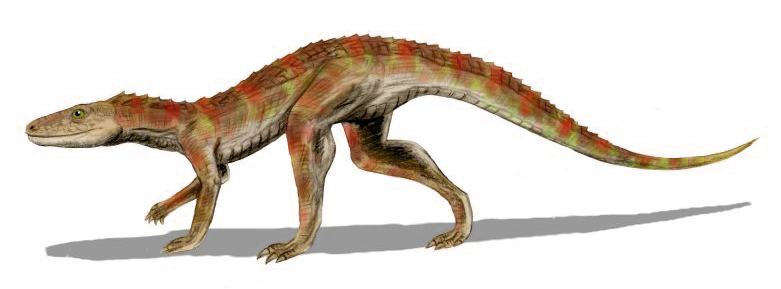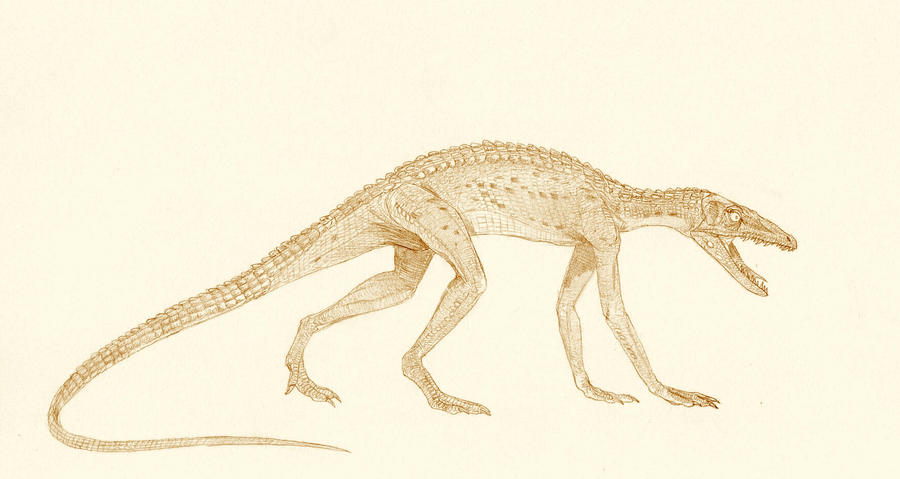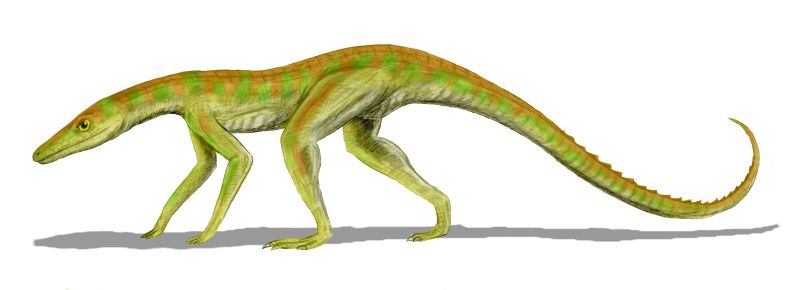[Recent Entries][Archive][Friends][User Info]
March 8th, 2012
| March 8th, 2012 | |
|---|---|
| 11:21 am [industrialterro] [Link] |
Hesperosuchus Hesperosuchus is an extinct genus of crocodylomorph reptile that contains a single species, Hesperosuchus agilis. Remains of this sphenosuchian have been found in Late Triassic (Carnian) strata from Arizona and New Mexico. Hesperosuchus was a contemporary of Coelophysis, a primitive predatory theropod dinosaur. Coelophysis was long thought to have been a cannibal, based on the presence of putative juvenile Coelophysis bones in the gut regions of a few adults. In at least one of these cases, though, the "juvenile Coelophysis" bones were actually those of a Hesperosuchus (or something very similar) instead. Эта позднетриасовая сфенозухия из Нью-Мексико была переописана в 1993 году. Hesperosuchus, так же, как и Sphenosuchus, обладал удлинённым передним отростком квадратно-скуловой кости, который протягивается внутрь от заднего отростка скуловой кости к основанию заглазничного отростка последней. При этом вышеупомянутый отросток как бы пересекает нижнее височное окно; у заднего края последнего в области челюстного сочленения скуловая, квадратно-скуловая и квадратная кости смыкаются друг с другом. Клыки дифференцированы слабо. Сфенозухии (Sphenosuchia) — группа примитивных вымерших наземных крокодилов, впервые появившихся в верхнем триасе и встречавшихся до поздней юры. Большинство из них были грацильными животными небольших размеров, имевшими перпендикулярное положение конечностей относительно земли. По происхождению наиболее близки к текодонтам. Сфенозухии считаются более примитивными представителями отряда Crocodyliа, чем другие причисляемые к этому отряду группы. Они отличаются своим чрезвычайно лёгким скелетом и предположительно бегающим способом передвижения, особенно род Terrestrisuchus, но именно эти признаки, вероятно, унаследованные от текодонтов, могут свидетельствовать о примитивности сфенозухий. Подотряд представлен некрупными формами размером до 2 м, обладавшими черепами со сравнительно короткой мордой и небольшим предглазничным окном, а также с хорошо развитой, как и у других крокодилов, системой воздушных синусов, связанных с полостью среднего уха. Коракоид имеет постеровентральный отросток. Некоторые сфенозухии, возможно, были квадрупедальными, как, например, среднетриасовый аргентинский Pseudhesperosuchus, имевший предглазничное окно, необычно большое для сфенозухий. Другие же виды, такие, как Gracilisuchus из среднего триаса Южной Америки и немногим более крупный Terrestrisuchus из верхнего триаса Англии, размером до 0,5 м, были, по-видимому, способны к бипедальному передвижению. The Crocodylomorpha are an important group of archosaurs that include the crocodilians and their extinct relatives. During Mesozoic and early Tertiary times the Crocodylomorpha were far more diverse than they are now. Triassic forms were small, lightly built, active terrestrial animals. These were supplanted during the early Jurassic by various aquatic and marine forms. The Later Jurassic, Cretaceous, and Tertiary saw a wide diversity of terrestrial and semi-aquatic lineages. "Modern" crocodilians do not appear until the Late Cretaceous. When their extinct species and stem group are examined, the crocodylian lineage (clade Crurotarsi) proves to have been a very diverse and adaptive group of reptiles. Not only are they an ancient group of animals, at least as old as the dinosaurs, they also evolved into a great variety of forms. The earliest forms, the sphenosuchians, evolved during the Late Triassic, and were highly gracile terrestrial forms built like greyhounds. During the Jurassic and the Cretaceous marine forms in the family Metriorhynchidae such as Metriorhynchus evolved forelimbs that were paddle-like and had a tail similar to modern fish. Dakosaurus andiniensis, a species closely related to Metriorhynchus, had a skull that was adapted to eat large marine reptiles. Several terrestrial species during the Cretaceous evolved herbivory, such as Simosuchus clarki and Chimaerasuchus paradoxus. A number of lineages during the Tertiary and Pleistocene became wholly terrestrial predators.
Tags: Вымершие рептилии, Триас, архозавроморфы, архозавры, диапсиды, крокодиломорфы, круротарзы, равизухии, сфенозухии |
| Time | Event |
| 11:58 am [industrialterro] [Link] |
Saltoposuchus Saltoposuchus is an extinct genus of small (3–5 feet), long- tailed crocodylomorph reptile (Sphenosuchia), from the Norian (Upper Triassic) of Europe. The name translated means "leaping crocodile". It has been proposed that Terrestrisuchus gracilis and Saltoposuchus connectens represent different ontogenetic stages of the same genus. In which case, the name Saltoposuchus would take precedence over Terrestrisuchus (1984). However, there is no consensus upon this yet. The front arms were short and the hind legs were long. It was clearly a swift bipedal runner, though it was probably comfortable on all four feet as well. It possessed pointed teeth and a double row of bony scutes along its back. It is not well known, though it used to enjoy some fame and was commonly referred to in popular literature as close to the ancestor of the dinosaurs, if not the ancestor of the dinosaurs. Superficially, it does resemble a small theropod and indeed, a skull of Saltoposuchus was formerly attributed to the theropod Procompsognathus. Current scientific opinion does not however consider Saltoposuchus to be ancestral to the dinosaurs. Saltoposuchus was classified in the Thecodontia, but this group is no longer considered valid (due to paraphyly). In some popular literature Saltoposuchus is erroneously referred to as a dinosaur.
Tags: Вымершие рептилии, Триас, архозавроморфы, архозавры, диапсиды, крокодиломорфы, круротарзы, равизухии, сфенозухии |
| Time | Event |
| 12:26 pm [industrialterro] [Link] |
Terrestrisuchus Terrestrisuchus ('land crocodile') is an extinct genus of early crocodylomorph that was about 50 cm (1 ft 8 in) long. Fossils have been found in Wales and date from the Late Triassic. Terrestrisuchus was a small, thin, lizard-like creature with long legs, bearing little to no resemblance to modern crocodiles, which are its distant relatives. The shape of the legs suggests that it was able to run fast. Its tail was particularly long, about twice the length of the head and body combined, and may have been used as a balance allowing the animal to rear up and run on its hind legs alone for brief periods. The legs were positioned directly beneath the body, meaning ancestral crocodiles such as Terrestrisuchus were cursorial and thus, their legs worked as pairs for galloping. Pseudo-galloping can be seen in modern crocodiles as they are known to use paired walking in rare but speed-dependent situations. Fossil evidence also shows that they were digitigrade, supporting their weight on only digits, or fingers. Some paleontologists suggest that Terrestrisuchus may be juvenile Saltoposuchus.
Tags: Вымершие рептилии, Триас, архозавроморфы, архозавры, диапсиды, крокодиломорфы, круротарзы, равизухии, сфенозухии |
| Previous Day | 2012/03/08 [Archive] |
Next Day |











